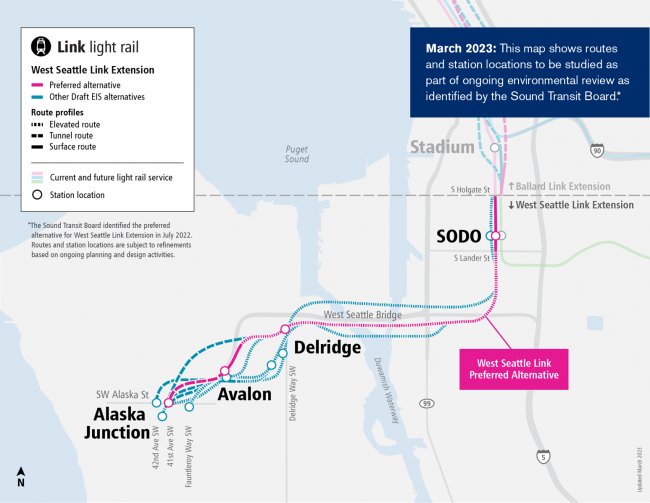West Seattle Link Extension gets the go ahead from the Federal Transit Administration
Tue, 04/29/2025
The Federal Transit Administration (FTA), an agency within the U.S. Department of Transportation (DOT), has issued a Record of Decision (ROD) regarding the West Seattle Link Extension (WSLE) Project. The ROD, dated April 29, 2025, signifies that the requirements of the National Environmental Policy Act (NEPA) have been satisfied for the construction and operation of the project by Sound Transit. It also includes findings on other environmentally related federal statutory requirements. It means that Sound Transit now has the go ahead to begin the process of design for Phase 1 and property acquisition.
The WSLE involves constructing approximately 4.1 miles of light rail service between the SODO area and West Seattle. The project corridor is divided into four segments: SODO, Duwamish, Delridge, and West Seattle Junction.
According to the ROD, the decision is based on years of intensive planning, environmental analysis, and public outreach. The transportation mode (light rail) and corridor were identified through Sound Transit's multi-year planning process for its Regional Transit Long-Range Plan and the Sound Transit 3 (ST3) plan. The ST3 plan, which included this project, was approved by voters in November 2016. The ROD follows the Sound Transit Board's selection of the preferred alternative as the project to be built on October 24, 2024.
The issuance of the Final Environmental Impact Statement (FEIS) evaluated the environmental impacts of the proposed project and various alternatives, including a "No Build" alternative. The NEPA process for the West Seattle Link Extension was conducted separately from the Ballard Link Extension due to differing project schedules.
As Lead Federal Agency for NEPA and Section 106 of the National Historic Preservation Act (NHPA), the FTA is implementing the Section 106 requirements through a Programmatic Agreement. The U.S. Army Corps of Engineers (USACE) and the U.S. Coast Guard (USCG) are cooperating agencies under NEPA and for Section 106 compliance, with the FTA acting on their behalf. The U.S. Postal Service (USPS) and the Port of Seattle are also identified as cooperating agencies due to their potential as affected property owners.
The FEIS and the ROD outline various mitigation measures for potential project impacts. These include maintaining access to existing bus stops and coordinating with transit operators to minimize disruptions. Sound Transit plans to work with the City of Seattle on on-street parking measures within a 0.25-mile radius of stations to discourage "hide-and-ride" parking while retaining curb use functions. Other measures include communicating information about street closures and construction hours, maintaining temporary pedestrian connections during closures, rerouting trails during construction, mitigating wetland and wetland buffer impacts, and complying with the National Marine Fisheries Service (NMFS) Biological Opinion for federally-listed species. Sound Transit also intends to coordinate with the Environmental Protection Agency (EPA) regarding work within the Harbor Island Superfund Site as design advances. Coordination with USPS and the City of Seattle is planned for the design of the Lander Street overpass to meet their requirements.
The project has garnered support from local government and business entities. The City of Seattle "enthusiastically supports" the WSLE project and the preferred alternative identified in the FEIS. The Seattle Metropolitan Chamber of Commerce and its members are also supportive of the light rail expansion, viewing it as essential for connecting communities and supporting the regional economy.
However, the project also faces significant opposition from various community groups and residents, including Rethink The Link (RTTL), SmarterTransit.org, and the SODO Business Improvement Area. Concerns raised include the project's escalating cost, cited as potentially reaching up to $7 billion or more for the 4.1-mile segment to West Seattle. Opponents argue that the project, as currently planned, may not significantly improve transit efficiency for West Seattle residents travelling downtown, potentially requiring transfers where direct bus routes currently exist. They also highlight negative impacts on businesses, residents, and the environment, including property displacements and impacts on wildlife habitat near areas like Pigeon Point and Longfellow Creek. Some critics advocate for reconsidering the "No Build" option or exploring more cost-effective alternatives like enhanced Bus Rapid Transit. Questions have also been raised about the project's funding and timeline, particularly the connection to the downtown Seattle and Ballard segments, which are perceived as uncertain. Some expressed concerns that the project might not align with potential federal funding priorities based on community demographics, citing a February 2025 PBS News report.
With the issuance of the ROD, Sound Transit is authorized to proceed into the final design phase. This phase includes finishing design, conducting additional engineering, seeking permits, and entering into contracts for project elements. Sound Transit has stated it will develop and implement a work plan during final design to improve its financial situation and inform a financially sound project. The projected completion year for the line is 2032. Property acquisition may begin following the ROD.


